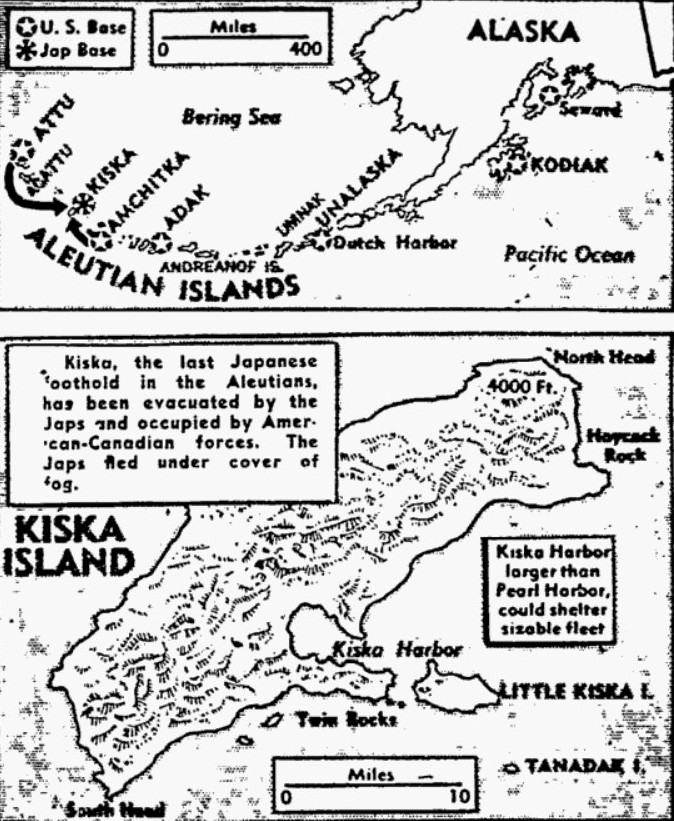Chronology of Aleutian Islands Campaign
1942
On June 3: Dutch Harbor is attacked by four Japanese bombers and about 15 fighters at 6 a.m. Dutch Harbor Time. The attack lasts 15 minutes. (Communiqué No. 83).
There are few casualties as a result of the Japanese raid. Several warehouses are set on fire, but no serious damage is suffered. (Communiqué No. 84).
At noon, Dutch Harbor Time, a second wave of enemy planes flies over Dutch Harbor on a reconnaissance mission. No bombs are dropped. (Communiqués Nos. 85‑86).
On June 4: At about 5 p.m., 18 carrier‑based bombers and 16 fighters attack U.S. installations at Dutch Harbor, Fort Mears and Fort Glenn. No damage is inflicted at Fort Glenn, minor damage is inflicted at Fort Mears, and at Dutch Harbor a warehouse and a few fuel oil tanks are set afire, and the station ship NORTHWESTERN, is sunk. (Communiqué No. 98).
On June 12: Small-scale landings by the Japanese on Attu Island are reported. Enemy ships are sighted in Kiska Harbor (Navy Department Press Release, June 12, 1942). Later reports reveal Japanese also occupy Agattu Island (Communiqué No. 98).
June 15‑July 3: U.S. Army bombers and Navy patrol planes carry out reconnaissance and attack missions against enemy installations on Kiska and enemy shipping in adjacent waters. One transport is reported sunk and 4 cruisers, 1 destroyer, 1 gunboat and 1 transport are damaged. (Communiqués Nos. 89‑90‑94).
July 4: U.S. submarines sink two destroyers and damage another off Kiska, and sink a third destroyer off Agattu. (Communiqué No. 95).
July 5: A U.S. submarine torpedoes and heavily damages an enemy destroyer in the vicinity of Kiska. (Communiqué No. 96).
July 6‑August 4: U.S. Army and Navy aircraft continue long-range bombing of Japanese installations on Kiska. U.S. submarines sink three more destroyers in the vicinity of Kiska. (Communiqués Nos. 99-103).
August 8: A U.S. cruiser and destroyer task force heavily bombards Kiska and enemy ships in the harbor. Severe damage is inflicted on the camp area. (Communiqué No. 103).
August 19: Sinking of a cruiser, or destroyer by a U.S. submarine is reported. (Communiqué No. 108).
August 22: Sinking of a large enemy merchant ship by a U.S. submarine is reported. (Communiqué No. 110).
August 30: Adak Island occupied.
September 14: U.S. Army bombers and fighters bomb and strafe enemy ships, aircraft and shore installations at Kiska. Two minesweepers are sunk, three cargo ships are damaged, three submarines are damaged, six planes are destroyed, and 500 enemy troops are killed or wounded. (Communiqué No. 127).
September 24‑25‑27‑28: U.S. Army bombers and fighters attack enemy shore positions on Kiska and ships off Kiska and Attu. Attacks of September 25‑28 are carried out by strong forces. (Communiqués Nos. 133‑137).
October 3: Announcement is made that U.S. forces have occupied positions in the Andreanof group of the Aleutian Islands, without opposition. (Communiqué No. 138). Adak is the island occupied (Communiqué No. 370), and the establishment of adequate airfields enables U.S. heavy bombers and fighters to operate from there in almost daily missions against the Japanese positions in the Western Aleutians. Throughout October, U.S. planes bomb and strafe the enemy ashore, and attack his shipping supply lines. (Communiqués Nos. 140‑143‑145‑150‑155‑157‑160‑161‑162‑170) Date of Adak occupation was August 30.
November 9: First Japanese activity on Attu Island in more than a month is noted as U.S. Army planes discover and destroy seven float‑type “Zeros” in Holtz Bay, Attu. (Communiqué No. 188) Earlier reconnaissance had detected no signs of continued enemy activity on Attu and Agattu (Communiqués Nos. 143‑145).
November‑December: Routine missions are carried out by U.S. planes against shore positions on Kiska and Attu and enemy shipping off both islands. (Communiqués Nos. 205‑218‑225‑227‑232‑235).
1943
January 12: U.S. forces occupy Amchitka Island, only 63 nautical miles from Kiska, without opposition from the enemy. (Occupation of Amchitka announced in Communiqué No. 370, on May 7, 1943.) Following the occupation, an airfield is established on Amchitka with enemy opposition consisting of a few ineffectual raids by small numbers of planes (Communiqués Nos. 268‑273‑281-287). Date of Amchitka occupation was January 12.
February: With completion of a closeup base on Amchitka, U.S. planes execute nine attacks on Kiska during the month, dropping more than 1,000 bombs, No U.S. planes are lost in these operations. (Communiqué No. 298).
March: Intensification of the campaign against the Japanese in the Western Aleutians increases. On March 15, U.S. Army heavy and medium bombers, escorted by fighters, carry out six missions against Kiska in the largest-scale attack thus far. (Communiqué No. 314). Raids on the enemy average better than one a day during the month.
On March 26, U.S. light forces patrolling to the westward of Attu Island engage a Japanese force composed of two heavy cruisers, two light cruisers, four destroyers and two cargo ships. Shell hits are scored on both of the Japanese heavy cruisers and one of the light cruisers. At least one torpedo hit is scored on an enemy heavy cruiser. U.S. vessels receive minor hits. (Communiqués Nos. 327‑365).
April: The month sees Kiska subjected to air attacks on a mass basis with occasional raids on Attu. The peak day is April 19, when 15 attacks are carried out against Kiska (Communiqué No. 351). Kiska twice is bombed 13 times in a day, on April 15 and April 25. (Communiqués Nos. 346 and 357). The month’s average is slightly under five missions a day.
May: Air attacks on Kiska and Attu continue during the early days of the month, and then, on May 11, U.S. forces land on Attu. (Communiqué No. 376). Supported by bombardment of enemy positions by U.S. naval surface forces, U.S. Army troops advance inland on Attu from the main landing points on the northeast and southeast ends of the island. In three weeks of fighting made difficult by Attu’s rugged terrain and unfavorable weather, U.S. troops complete conquest of Attu. By June 1, all organized enemy resistance has ceased. (Communiqué No. 401).
June: U.S. forces, now in possession of key positions in the Western Aleutians, concentrate attention on Kiska, and carry out bombing and strafing missions whenever the weather will permit. (Communiqués Nos. 400‑402‑403‑407‑409414‑420‑423‑424‑425‑427).
July: U.S. naval surface forces Join in the assault on Kiska, bombarding enemy shore positions on July 6‑9‑11‑14‑15‑20‑22‑30. (Communiqués Nos. 436‑438-439‑441‑442-446‑448‑455). Meanwhile, U.S. Army bombers and fighters continue heavy attacks on all enemy positions on the island.
August 1‑14: Kiska undergoes concentrated assaults by U.S. forces both from the air and sea. (Communiqué No. 460).
On August 15, U.S. and Canadian forces landed on Kiska. (Communiqué No. 459).
Communiqué No. 460
North Pacific.
In the period from August 1 to August 14, inclusive, U.S. Army and Navy aircraft and heavy and light U.S. naval surface units carried out the following previously-unannounced attacks on Kiska Island and Little Kiska
On August 1: Liberator heavy bombers (Consolidated B‑24) dropped bombs through solid overcast on the Kiska main camp area.
On August 2:
-
In the afternoon Liberators attacked North Head on Kiska, and scored hits in the area.
-
Immediately following the above air attack, heavy and light U.S. naval surface units heavily bombarded the main camp, submarine base, North Head, South Head and Gertrude Cove on Kiska Island, as well as enemy positions on Little Kiska. More than 2,300 rounds of large and medium caliber shells were fired at the targets, with no return fire from the enemy.
-
Early the same evening Mitchell medium bombers (North American B‑25) and Lightning fighters (Lockheed P‑38) bombed and strafed Little Kiska.
On August 3:
-
In the early morning, light Naval surface units shelled Gertrude Cove and the main camp area on Kiska. Return fire by the enemy was light and brief.
-
Four bombing and strafing attacks were carried out by Mitchell medium bombers and Warhawk (Curtiss P‑40) and Lightning fighters on North Head, South Head, the runway, seaplane hangar area and the main camp on Kiska. Little Kiska was strafed. Hits were observed in all target areas.
On August 4:
-
Shortly after midnight, a Navy Catalina patrol bomber (Consolidated PBY) dropped explosive and incendiary bombs on the Kiska main camp and submarine base. Large fires resulted from the attack.
-
During a 12‑hour period from morning to evening, 18 attack missions were carried out against North Head, South Head, the runway, main camp and submarine base on Kiska and Little Kiska. Large forces of Liberator heavy bombers, Mitchell medium bombers, Army Dauntless dive bombers (Douglas A‑24), and Lightning and Warhawk fighters participated in these attacks. In addition to the bombings, cannon‑firing‑ Mitchells successfully attacked shore installations, while the fighter planes strafed at low altitudes. Many explosions resulted and numerous fires were started. The enemy’s opposition consisted of sporadic antiaircraft fire.
On August 5: In the early morning light Naval surface units shelled Gertrude Cove and the main camp on Kiska. No return fire was encountered.
On August 6: Light naval surface units again bombarded Kiska, scoring hits in the target area. There was no return fire.
On August 8: The Kiska main camp and the Gertrude Cove area were the targets in a further bombardment by light Naval surface units, with no return fire.
On August 9: Light Naval surface units shelled Gertrude Cove, the main camp and enemy positions on a hill North of Reynard Cove.
On August 10:
-
Before dawn, Gertrude Cove and the main camp again were bombarded by light Naval surface units.
-
Large forces of Liberator heavy bombers, Mitchell medium bombers, Army Dauntless dive bombers (Douglas A‑24), and Lightning and Warhawk fighters carried out 24 bombing and strafing missions on Kiska. Only light antiaircraft fire was encountered. Many fires were started.
-
During the night, a Catalina patrol bomber dropped bombs on Kiska.
On August 11:
-
In the early morning, light Naval surface units shelled South Head and Gertrude Cove, starting fires.
-
Gertrude Cove, Reynard Cove, North Head and Little Kiska were the targets of 21 bombing and strafing missions carried out during the day by Liberator heavy bombers, Mitchell medium bombers, Army Dauntless dive bombers (Douglas A‑24) and Lightning and Warhawk fighters. Fires were started in all areas and considerable debris was observed in enemy emplacements on Little Kiska.
-
A Catalina patrol bomber dropped bombs on the main camp and Gertrude Cove during the night.
On August 12:
-
Shortly after midnight, a light Naval surface unit shelled Kiska.
-
In the morning, heavy and light Naval surface units bombarded the south coast of Kiska. Gertrude Cove and Bukhti Point were the main targets. There was no return fire.
-
The Kiska area was heavily bombed and thoroughly strafed during the day in 20 attacks by forces of Liberator heavy bombers, Mitchell medium bombers, Army Dauntless dive bombers, and Warhawk and Lightning fighters. Many fires were started.
On August 13:
-
Light U. S. Naval surface units bombarded Kiska early in the morning, drawing no return fire.
-
During the afternoon nine bombing and strafing missions were carried out against Kiska by U.S. Army Liberator, Mitchell and Dauntless bombers and Lightning fighters. Buildings at Gertrude Cove and North Head were destroyed by direct hits, and fires resulted at Gertrude Cove, North Head, the main camp and north of Reynard Cove. Light antiaircraft fire was encountered.
On August 14:
-
In the early morning hours, a Navy Catalina three times bombed installations on Kiska, with unreported results.
-
At hourly intervals, light U.S. Naval surface units bombarded Kiska four times. No return fire was encountered.
-
In the late afternoon U.S. Army Liberators, Mitchells and Lightnings bombed and strafed enemy positions on Kiska. Results were not reported.

